Introduction
First of all, I’m not trying to sell this projector. I consider it a family heirloom. The real reason I’m building this page is to share with everyone the details of this projector. There doesn’t seem to be much out there on the net about this thing (except for one or two pages containing references to undisclosed information that someone, of course, wanted to sell me). The industrial design that went into this unit is very interesting. I hope, through this site, to preserve the detail of its features and functionality, as well as information on how to use it and take care of it.
This projector was manufactured by the Victor Animatograph Corporation. From what I can tell, it’s audio portion was called the “Animatophone Type 13”, and the projection portion was called “Model 40”. A quick search around the net leads me to believe that the Model 40 was manufactured in 1939.
You can view large versions of most of the images on this page by clicking on them.
Here’s a closeup shot of the name plates on the unit. It’s not clear why they separated the naming of the audio and projection portions of a non-modular projector.
History of This Particular Projector
My grandmother has just moved from her house of 30 years in Regina Saskatchewan (Canada). From the usual purge of “stuff” that comes with such a move, I inherited a Victor Animatograph Corporation Animatophone Model 40, Type 13 16mm movie projector. The main reason I wanted it was because I remember watching in awe as my grandfather threaded the film when I was a kid. He treated this projector with great care as he did all his things.
All of the film ever shown on this unit was of their kids (my mother, aunts and uncles, etc) and hours of footage of power line construction (my Grandfather’s profession) and various vacations from the ’50s. Movie-night was a rare occasion, occuring only when the whole family was back in town for a visit. We’d all pile into the basement and Grandpa would start threading. We’d get about two films in when everyone started to groan about how boring power line construction is. The short clips of the kids doing various things had been long memorized by everyone, being the most interesting footage–always good for a laugh.
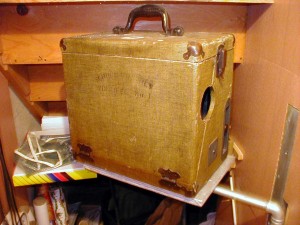
The projector stayed in this small room under the basement stairs for at least 25 years and was never moved to my knowledge.
The projector is very loud, but my Grandfather overcame this by permanently placing it under the basement stairs. He cut a hole in the wall just large enough to allow the image to shine out onto the screen on the opposite end of the basement. You couldn’t close the door under the stairs or the 750W bulb would overheat in minutes.
The Case
When in its storage configuration it looks like a suitcase. It must have been considered “portable” for the time but I swear it weighs 70 lbs. I don’t own a scale so I can’t check. The speaker with a built-in amplifier sits on top of the projector and buckles to it. On top of that, is a lid with a suitcase handle. The buckles are designed so that the lid is also compatible with the projection unit without the speaker so you can carry it around without the sound capability. This doesn’t help the weight problem since the speaker weighs about one pound. At the time of its manufacture, sound-on-the-film was a reasonably new feature. This may explain why the “Animatophone Type 13” branding was separate from the projection unit branding–perhaps they were sold separately until shortly before this projector was made–just a guess.
Here the case is shown in its two carrying configurations–with audio and without.
A stencil painted on the side of the case says “Winnipeg Board of Education No.1”. I presume this was the previous owner before my family got it.
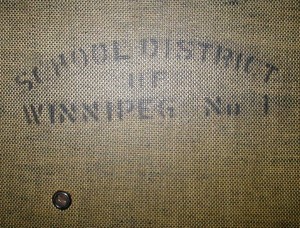
I’m not sure when this projector was owned by Winnipeg Board of Education–but apparently it was.
The Audio Unit
The speaker segment of the case doubles as a storage box for cables and spare parts. The speaker contains spare bulbs, instructions, a threading diagram and a ton of cables. There seems to be a built-in amplifier using one tube in the corner of the box that needs to be powered independently from the projector.
Unfortunately my family didn’t own a camera that recorded sound, so I can’t verify whether or not the audio components still work. I can get some static and a hum out of it that sounds promising enough.
Here are some shots of the speaker case and the spare bulb and tubes that were in it.
The Projector
The take-up reel and film reels are powered through the use of long steel belts; they’re actually more like springs. There are two spring-belts for normal operation, and a 3rd that you use only when you want to rewind. You actually pull the spring-belt off the pulley on the film arm, and replace it with the rewind spring-belt that runs much faster for rewinding.
Here you can see the spring-belts hooked onto the case in storage configuration. You can see the 3rd spring in the middle left hole on the top. This is pulled out and attached to the rear arm for rewinding. BTW, I made up the term “spring-belt”.
The path the film follows through the projector is similar to what I remember from the old 16mm’s in high school (no I was not in the AV club). One difference most noticeable is that the film travels from the back reel to the front. Because the film is symetrical with holes on both sides, it’s easy to feed the film from the wrong side of the film reel resulting in a reversed image.
Here are some shots of the inside of the projector.
Assembly
I’m a software engineer by trade and I have to say it took me a long while before I figured out how to hook everything up. The most hilarious part about the assembly is that the audio signal cables use two-prong electrical outlet connectors! This can make for an exciting mistake when you plug an input lead for the speaker into an 110V AC plug by accident. Luckily my grandfather had labeled the correct audio signal wire. There is one wire that I can’t figure out: it’s a non-standard two-prong outlet plug with an additional plug just under the center of the normal two. I can see where this plugs in, but I can’t figure out what it’s for. If anyone knows, please leave a comment. It might be for a microphone or something.
The reel arms are stored in the bottom of the projector case with a pressure-screw to keep them from rattling around. The reel belts are metal and spring-like allowing them to slide if something gets stuck. They’re stored on hooks in the top of the case and are permanently mounted on their motor pulleys. In all there are no loose parts when everything is stowed correctly–hard to say for many modern devices like video cameras or even still cameras for that matter with accessories falling out all over the place or getting lost.
To assemble, you simply insert the reel arms into the top of the projector, hook up the drive belts, and plug in the power.
Documentation
There was some documentation still with the projector under the stairs. Taped on the wall was the threading diagram. In addition to this was a large sheet of thick paper. I have taken some digital shots of both documents. The shots aren’t really clear enough to read and are provided here to give everyone an idea of what the manual to this device looked like. If there’s interest I’ll scan the docs to make them more legible.
The other document is a large sheet of thick paper that’s double sided. This has the instructions on one side, and a maintenance and service manual description on the other. The instructions make use of many closeup photos of each step of operation that are very hard to make out. I suppose, being a projector company, they wanted to use photos instead of diagrams.
One side is titled “Operating Instructions Victor Animatophone”.
The other side is titled “Cleaning · Locating Trouble · Making Replacements”.
Film
The film that came with the projector is 16mm. I’m not sure if this is normal for 16mm, but the film is perforated on both sides so it’s possible to put the film in backwards. The film case is quite interesting in itself. It’s steel and has a front lip that folds down so you can label the can slots.
Here are some shots of the film case and a close up of one of the cans.
Summary
Above is all the info I have on this projector to date. I hope that readers with additional info will contact me so I can fill this page out over time. If anyone has any questions, would like more information, or has any comments about this page feel free to leave a comment. I hope you’ve found this page useful.
If we all put the pieces together hopefully we can get a complete record of the history of this type of projector, how to take care of it, a parts list, etc. It’s a great unit and I hope this site can help to keep mine running for another 70 years.


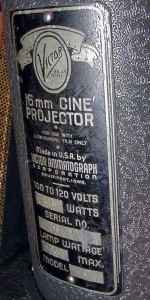

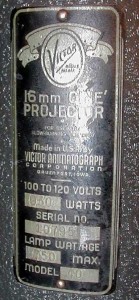
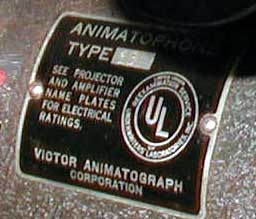
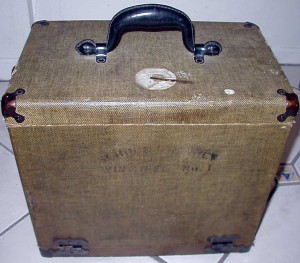
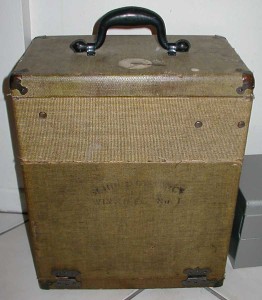
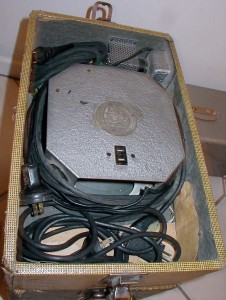
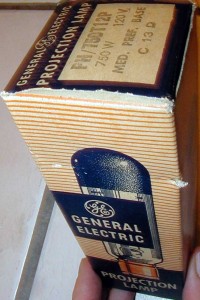
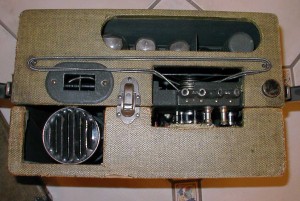
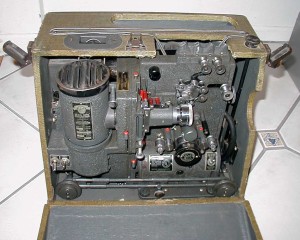
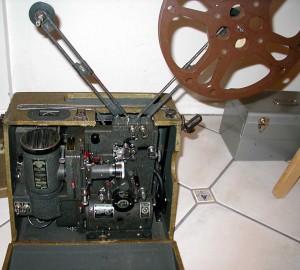
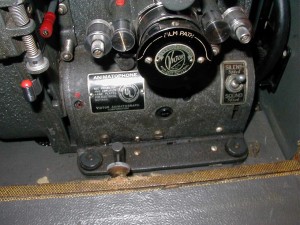
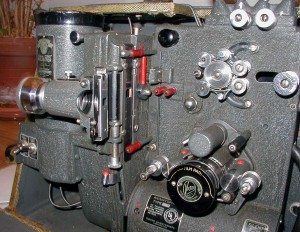
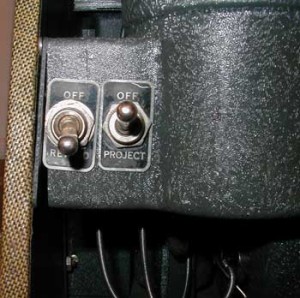
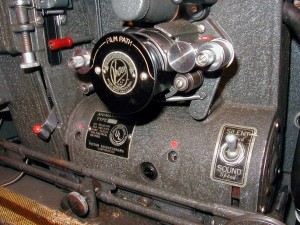
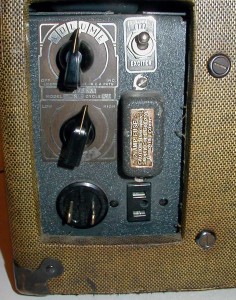
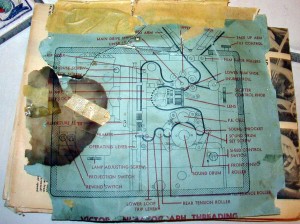
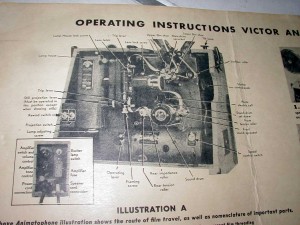
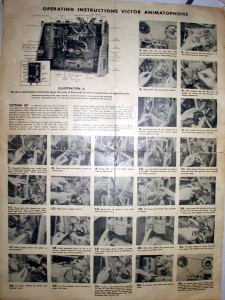
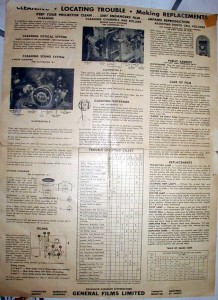
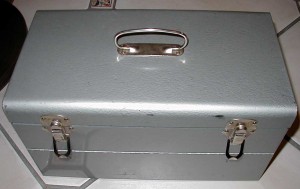
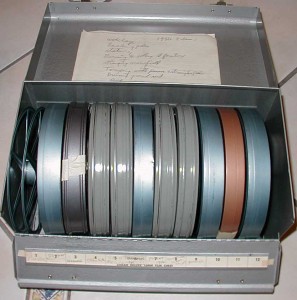
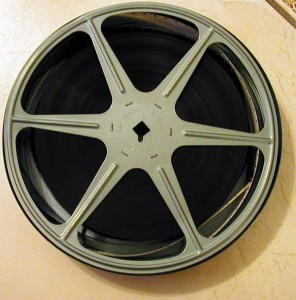
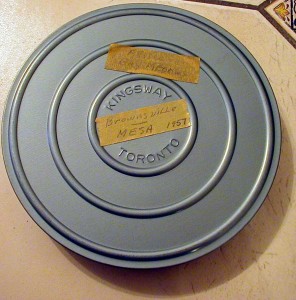
The strange looking outlet that resembles a two-prong power plug with an extra plug in the center is for the speaker. Victor used this type of plug (or something similar) right up until the company closed down around 1990. They were the last U.S. maker of 16mm projectors, and their factory had moved in the 1950’s from Davenport, IA to Plainville, CT, after being bought by the Kalart Mfg. Co., makers of Kalart photo equipment and Craig movie editors. The company name was changed to the Kalart-Victor Corporation.
If your speaker plug is missing, a non-polarized power plug could, I guess, be used to replace it. (Just make sure no one tries to plug the speaker into the wall socket!!)
16mm silent film, like your home movies, has sprocket holes on both sides of the picture. Sound film has holes on only one side, and an optical sound track on the other; therefore cannot be threaded backwards. If you run silent film over the sound “head” with the exciter lamp and amplifier turned on, you’ll hear a loud PRBBBBBBRRBBB noise, which is the photo cell “reading” the holes in the film in place of the soundtrack.
By the way, while numerous improvements were made in the machine over the years, the very last Victor/Kalart models of the late 1980’s still threaded EXACTLY like yours! They are durable, dependable, and gentle on films.
Thanks a lot for the info. Will try to print it. I just picked one up at an antique store on Maine. It actually runs and the projection light works. Quite the machine! I need to do more clean up as some mice took up residence. I’ll have to get a couple of cine movies to try it. Havn’t read your whole article but will. .
I have a model 16s s/n 3387
Can you help with some information
DO YOU KNOW WHERE I CAN BUY A LIGHT SOURCE FOR THE VICTOR NO 2 35MM PROJECTOR BUILT AROUND 1920? ALSO ANY EXTRAS SUCH AS LENS FOR THIS PROJECTOR?
Do you know where I can find parts for this unit? I am looking for sound sprocket drive gear # 17950
I’m sorry I don’t. I’ve never found a resource for particular parts.
I have the same exact unit for sell along with a lot of other antiques from a clean out but I know nothing about antiques so I need someone honest to help me
Hi, what a great resource you have provided! I just picked up this unit today in an antique store in my hometown. I need to replace the bulb but otherwise it functions. You mentioned that you would be willing to scan the documentation you have for this? They are tough to read as you noted. I have none of the documents so it would be greatly appreciated as I would like to get this thing running top notch. I do not have the speaker or top cover and I am planning on fashioning a feed from the speaker output to something else but having the specs would help me out a lot.
Thanks!
I have a Model 40 PROJECTOR which I am willing to sell. It is complete except for the reel arms which are missing. Photos available.
Of possible interest:
http://www.youtube.com/watch?v=JcOWBL_1uRg
Very cool!
Ben, thanks for sharing that information on that very cool machine of yours. I to have a model 40 serial #91687. Judging by your serial # it was built before yours. I have read that as little as 20 units were made per year? I photocopied a advertising folder 1938 era and you could buy this machine for $187.50. The unit I have differs from yours only that it has a separate suitcase for the speaker with the big 12 speaker with the metal victor logo on the front of speaker. It also came with another suitcase for the traveling projectionist for his suits. All suitcases matched.
It came from uncle Mike from the wife side of the family. He bought it new and would rent movies and go around the north of Alberta and show movies for 25 cents a ticket in the late 30s. What a way to make a living.
I have one that’s a model 40 in this your number is 904 46 so how old you think money’s
I will be selling this exact projector for parts. It is in fair condition. The take up arms are unfortunately missing. the motor works but the bulb does not.
I have exhausted all resources to find a pull-down-claw for my Kalart-Victor 90-25 projector. Hopefully someone can help me.
I do a lot of volunteer work at a local senior center showing my classic movie short for several years. The seniors love them; however, can do this anymore due to a broken pull-down claw.
You can buy the projector 90-25 parts projector on eBay there one for $35.00 I hope this help you
I have a Model 40 Animatophone made by Victor Animatograph Corp. (later Kalart-Victor) that I last ran five years ago. It sits in a closet with a double 4″-square glass window projecting to a screen at the other end of the room. I’m now trying to locate a technician that can clean and lube the mechanism before I start using it again.
I also have a Victor Mod. 65-25 machine. Anyone have any data on it?
Dick
i have projector Victor 16mm cine model 40 ( 11j7) how much i can get for projector.
help me please
I have a complete, operational Model 40, type 13 that needs a new home. It has been stored inside since the 1940s and I would consider it to be in excellent condition. Includes reels, film splicer, etc. Last operated was in 1972.
Thanks for this information! I picked one of these up for $9.99 at a thrift store. (It was marked $99.99, but as soon as we showed any interest in it, the price dropped 90%; clearly they wanted to get rid of it!)
It didn’t come with a speaker, or with the third belt, more’s the pity. I was mainly interested in the tube amplifier; you can sometimes make a killer tube guitar amp out of an old 1940s PA system or even a radio. Accordingly, I took the projector side out of the case, and can tell you that the Animatophone has a huge power transformer. This baby should be pretty loud when hooked up to a decent speaker. The amp I have was “retrofitted” to drive two speakers (I think), by simply wiring in a standard AC wall plate with two two-prong outlets! That confused me for a while, until I realized that the AC-in jack was the one with the prongs sticking out. (I guess I was near accidental death for a few minutes…)
The tubes are:
Rectifier: 5Y3 GT
Power: 2 x 6L6G
Phase inverter 6SN7
Preamp – unknown, because I can’t get the metal cover off.
This set-up is almost identical to contemporaneous Gibson guitar amps, and not that different from large Fender amps of the 1950s like the Bassman and Deluxe. I am going to see about fabricating a speaker cable and hooking it up to a 1×12″ or 2×10″.
I’ve found one of these as well and was wondering if you know what they’re worth or if its worth selling it. Mine isn’t in as great of condition as your’s but it’s still functional from what i can see, I haven’t plugged it in and I don’t plan on plugging it in just incase something goes wrong and it devalues it. If you know anyone looking for one or any information on it that could be useful I’d really appreciate if you emailed me at Binxsie@gmail.com. Thanks 😀
ALSO i have the speaker with it as well as the oil kit and extra belt.
I have a Victor anmatograph 16mm. Serial number 3064 , 850 watts. Original case, oil can, lubricating oil, 1 reel. Model #16. Would you happen to know any information on this like the year and value? Inherited from my great uncle who was a photographer. Thank you for any information you could provide for me. Kyja Hurst
I own a pristine Kalart Victor 82-25 transistorized 16mm sound projector 1960) and am desperately looking for a service manual in order to recap the solid state amplifier. I’ve looked everywhere on the net, in vain. All I could find was a service manual for a 75-25 which has a tubed amplifier. Can anyone email me with information? The manuals using run around $15 or so.
This outfit was supplied with all of the Kalart Victor parts the factory had upon closing. You can contact them regarding availability of parts.
H B Communications, Inc.
15 Corporate Drive
PO Box 689
North Haven, CT 06473
Phone: 203-234-9246
Fax: 203-234-2013
Yes, Please scan if you haven’t already! Have you scanned? if so, where may I get a copy?
Is the plug (or wire as you call it} that you can’t identify pictured? The speaker cord on my model 70 sounds like what you are describing. The third prong is a safety/index pin to ensure the speaker is plugged in with the correct polarity and prevent someone plugging the speaker into the wall. 🙂
I just received one of these, with the speaker.
It is a beautiful.
Mine also has Army green canvas covers on the projector and speaker (these covers have the Victor logo printed on them), like they were used by the military.
I also have a mint copy of the parts and service manual.
Can you tell me what oil to use and how much in each port? I just picked up a 60 and trying to figure it out.
Thanks
I’m sorry, I don’t have that info. I just put a few drops in each very infrequently.
i have a model 6 cant find any info
How much is a victor model 40
16 mm projector
Animatophone type 13 worth
Victor Animatograph Model 40 16mm projector: I am in need of a motor drive belt (not the spring type) Belt
circumference = 20 inches
Diameter = 6 inches
shape is a slight “V” – outer flat surface is 1/4″ wide; Inner flat surface is approx. 1/16 inches wide.
I have a tweed Victor External Speaker cabinet that goes with your Victor Model 40 Projector. It is the stand alone cabinet with the Victor grill and grill cover. Original 12″ speaker with transformer and wiring with connector) All original from 1938-1942(?). Its in real good condition and I don’t want to just throw it away. It seems very rare.
Can you advise on where I might be able to sell the unit so it gets to a good home for antiques preservation?
Thanks for all your information.im restoring a model Victor. 60b projector and I really needed that info.
Buen día, saludo desde argentina Buenos Aires. Muy la historia familiar que tiene tu proyector.
Soy Gastón Giavino y amo estos equipos, te escribo porque he comprado un amplificador solamente, igual al que tienes y, lo estoy restaurando por que quede en mi colección. Pero me falta el esquema eléctrico que en la valija venía. Usted sería tan amable si está en sus posibilidades hacer un scanner de ella y enviármela? Si esto no es posible le agradezco todo el contenido compartido que ha expuesto.
Saludos!!!!
These were the school machines of my Idaho ’45 – ’57 youth, and I loved ’em. Their one unique feature amongst B&H and MovieMites and others of the period was the clutch, between the drive motor and the film feed, with two mechanical sensor levers above and below the optical gate. For pictures the film movement is jerky while for audio it must be smooth, so there are loops of film above and below the gate which must not be lost or the advance claws will chew up the film. Sometimes things would slip – so if either loop was lost the film would yank the lever and disengage the clutch, sparing the film. I lugged these around thru my high school years.